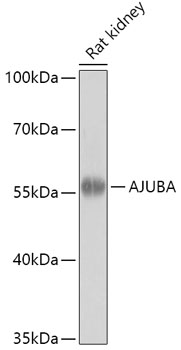Anti-AJUBA Antibody (CAB18153)
- SKU:
- CAB18153
- Product type:
- Antibody
- Reactivity:
- Human
- Reactivity:
- Mouse
- Reactivity:
- Rat
- Host Species:
- Rabbit
- Isotype:
- IgG
Description
| 抗体名: | Anti-AJUBA Antibody |
| 抗体コード: | CAB18153 |
| 抗体サイズ: | 20uL, 50uL, 100uL |
| 申し込み: | WB IHC |
| 反応性: | Human, Mouse, Rat |
| 宿主種: | Rabbit |
| 免疫原: | Recombinant Protein of human AJUBA. |
| 申し込み: | WB IHC |
| 推奨希釈: | WB 1:500 - 1:2000 IHC 1:50 - 1:200 |
| 反応性: | Human, Mouse, Rat |
| ポジティブサンプル: | Rat kidney |
| 免疫原: | Recombinant Protein of human AJUBA. |
| 精製方法: | Affinity purification |
| ストレージバッファ: | Store at -20°C. Avoid freeze / thaw cycles. Buffer: PBS with 0.02% sodium azide, 50% glycerol, pH7.3. |
| アイソタイプ: | IgG |
| 順序: | Email for sequence |
| 遺伝子ID: | 84962 |
| Uniprot: | Q96IF1 |
| セルラーロケーション: | |
| 計算された分子量: | 13kDa/56kDa |
| 観察された分子量: | 57kDa |
| 同義語: | AJUBA, JUB |
| バックグラウンド: | AJUBA (ajuba LIM protein) is a protein-coding gene. GO annotations related to this gene include chromatin binding and actin filament binding. An important paralog of this gene is LPP. |
| UniProt Protein Function: | JUB: Adapter or scaffold protein which participates in the assembly of numerous protein complexes and is involved in several cellular processes such as cell fate determination, cytoskeletal organization, repression of gene transcription, mitosis, cell-cell adhesion, cell differentiation, proliferation and migration. Contributes to the linking and/or strengthening of epithelia cell- cell junctions in part by linking adhesive receptors to the actin cytoskeleton. May be involved in signal transduction from cell adhesion sites to the nucleus. Plays an important role in regulation of the kinase activity of AURKA for mitotic commitment. Also a component of the IL-1 signaling pathway modulating IL-1- induced NFKB1 activation by influencing the assembly and activity of the PRKCZ-SQSTM1-TRAF6 multiprotein signaling complex. Functions as an HDAC-dependent corepressor for a subset of GFI1 target genes. Acts as a transcriptional corepressor for SNAI1 and SNAI2/SLUG-dependent repression of E-cadherin transcription. Acts as a hypoxic regulator by bridging an association between the prolyl hydroxylases and VHL enabling efficient degradation of HIF1A. Positively regulates microRNA (miRNA)-mediated gene silencing. Negatively regulates the Hippo signaling pathway and antagonizes phosphorylation of YAP1. Interacts with GRB2, PIP5K1B and SLC1A2. Interacts with AURKA; the interaction occurs during mitosis and both proteins are phosphorylated as they form a complex. Interacts with CTNNA1 and with F-actin. Interacts with LATS2; the interaction occurs during mitosis and the complex regulates organization of the spindle apparatus through recruitment of TUBG to the centrosome. Forms a complex with SQSTM1, PRKCZ and TRAF6. Component of the GFI1-AJUBA-HDAC1 repressor complex. Interacts directly (via the LIM domains) with GFI1; the interaction results in the HDAC-dependent corepression of a subset of GFI1 target genes, and is independent of the GFI1 SNAG domain. Interacts with HDAC1, HDAC2 and HDAC3. Interacts with SNAI2/SLUG (via SNAG domain) and SCRT1 (via SNAG domain). Interacts with EIF4E, EIF2C1, EIF2C2, DCP2, DDX6, LATS1, LATS2, SAV1, EGLN2/PHD1 and EGLN3/PHD3. Interacts (via LIM domains) with isoform 1 and isoform 3 of VHL. Interacts (via LIM domains) with SNAI1 (via SNAG domain). Belongs to the zyxin/ajuba family. |
| UniProt Protein Details: | Protein type:Transcription, coactivator/corepressor; Motility/polarity/chemotaxis; Cell adhesion Chromosomal Location of Human Ortholog: 14q11.2 Cellular Component: transcription factor complex; focal adhesion; lamellipodium; plasma membrane; microtubule organizing center; intercellular junction; nucleus; cytosol Molecular Function:actin filament binding; protein binding; zinc ion binding; chromatin binding; transcription corepressor activity; alpha-catenin binding Biological Process: lamellipodium biogenesis; focal adhesion formation; negative regulation of kinase activity; regulation of GTPase activity; positive regulation of I-kappaB kinase/NF-kappaB cascade; transcription, DNA-dependent; glycerophospholipid biosynthetic process; negative regulation of transcription from RNA polymerase II promoter; miRNA-mediated gene silencing; positive regulation of cellular biosynthetic process; regulation of cell migration; positive regulation of MAP kinase activity; positive regulation of protein complex assembly; calcium-dependent cell-cell adhesion; response to hypoxia; mitotic cell cycle; G2/M transition of mitotic cell cycle; wound healing, spreading of epidermal cells |
| UniProt Code: | Q96IF1 |
| NCBI GenInfo Identifier: | 574273432 |
| NCBI Gene ID: | 84962 |
| NCBI Accession: | NP_001276026.1 |
| UniProt Secondary Accession: | Q96IF1,A8MX18, D3DS37, |
| UniProt Related Accession: | Q96IF1 |
| Molecular Weight: | 56,934 Da |
| NCBI Full Name: | LIM domain-containing protein ajuba isoform 3 |
| NCBI Synonym Full Names: | ajuba LIM protein |
| NCBI Official Symbol: | AJUBA |
| NCBI Official Synonym Symbols: | JUB |
| NCBI Protein Information: | LIM domain-containing protein ajuba; jub, ajuba homolog |
| UniProt Protein Name: | LIM domain-containing protein ajuba |
| Protein Family: | LIM domain-containing protein |
| UniProt Gene Name: | AJUBA |
| UniProt Entry Name: | AJUBA_HUMAN |


